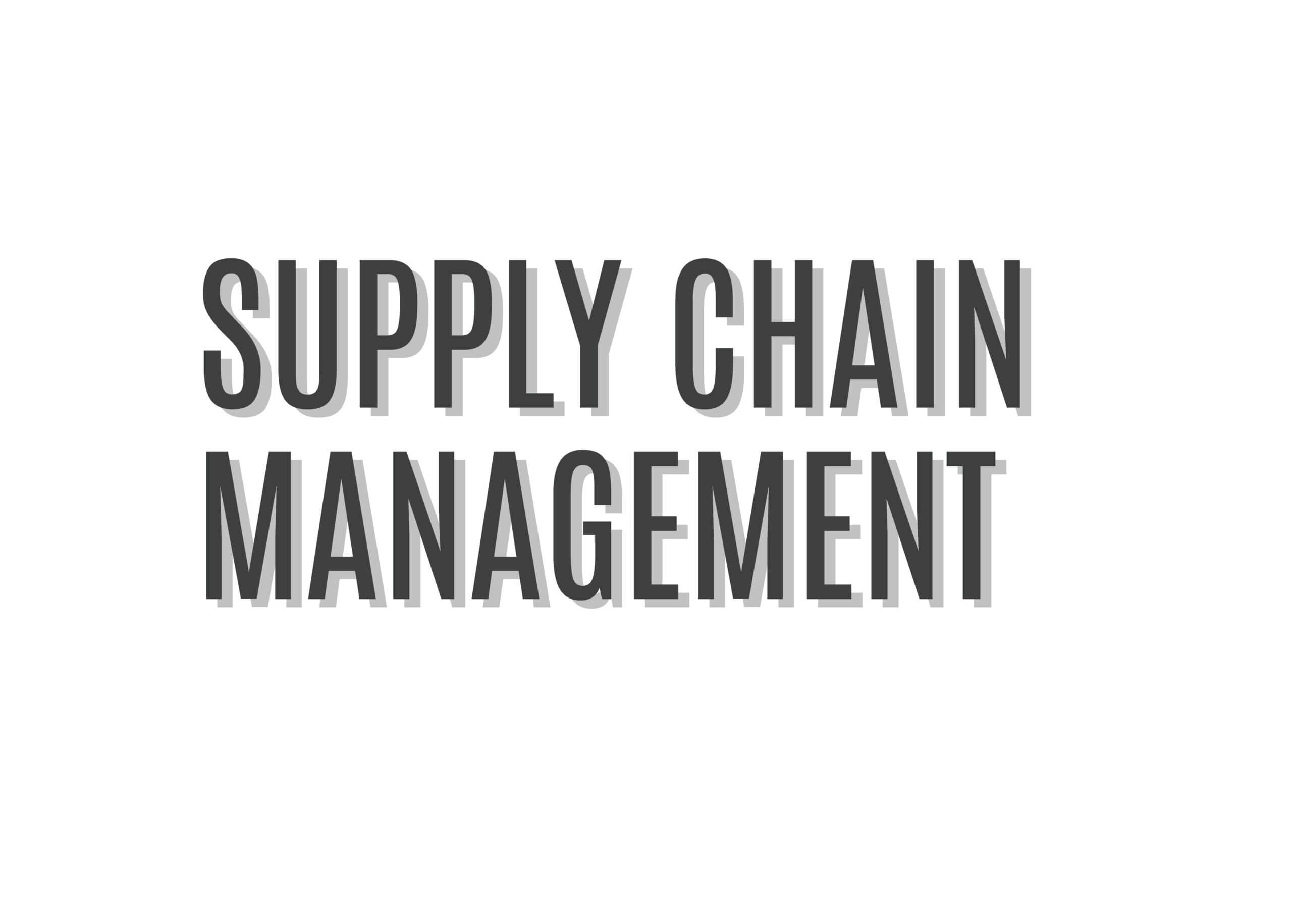Supply Chain Management: Guidelines and Resources
Copyright, Carter McNamara, MBA, PhD
This topic in the Library is written especially for those new to SCM. It also aims to include nonprofits and small businesses in its scope. As you read this topic, think about the activities of a certain product or service that you know about, or are even involved in developing or providing to customers. Before reading this topic, you might read about the Relationship Between Managing Supply Chain, Operations, Quality, Customer Relationships and Customer Service.
Sections of This Topic Include
What is Supply Chain Management?
Planning Your SCM
Developing Your SCM
Managing Your SCM
General Resources
Also consider
WHAT IS SUPPLY CHAIN MANAGEMENT?
You Are Probably Part of a Supply Chain
What is a Supply Chain?
If you work in an organization that produces tangible offerings (products) and/or intangible offerings (services) to customers, and if you are involved in any the following organizational activities, then you are part of a supply chain:
- Strategic planning about what market, products and services are provided by the organization
- Estimating what the consumer needs (forecasting demand) will be for those products and services
- Making sure there will be sufficient resources (materials planning) to meet that demand
- Identifying who will supply those resources (who will be the suppliers)
- How you will buy (or procure) them
- How you will get the resources into your organization (these are matters of inbound logistics)
- How you will build (or manufacture) them
- How you will store (or warehouse) all of them (that is, how you will inventory them)
- How you will get the products or services delivered to the customer, for example, sold directly or through a retailer (these are matters of distribution and outbound logistics)
- How you will ensure the product or service meets or exceeds the customer’s expectations (matters of customer service and customer relationship management)
NOTE: All of the activities and terms in the above parentheses are the typical sequential components in a supply chain.
Other Definitions of a Supply Chain
This is sometimes where readers start to get overwhelmed and confused when reading about supply chains and SCM. If they have heard of the more common topic of logistics, then descriptions of supply chains can seem even more confusing.
However, Intek Freight and Logistics, Inc provides a very useful description of a supply chain, as well as how it differs from logistics:
“To sum up logistics and supply chains, think of a football game where logistics is the game on the field of play and the supply chain is the stadium where the game is played.
From the game perspective of the analogy, the movement of the ball up and down the field of play to deliver a score is logistics.
The stadium, on the other hand, represents all the physical and communication components. Think of the massive amounts of money put into a professional football stadium to deliver the best experience for the buying customers (the fans). There is the stadium itself, plus the communication points between coaches in the box to coaches and players on the field. The communication network allows calls, still pictures and replay videos to execute to the highest levels to score points and have the customers standing on their feet cheering for more.
The feedback mechanism of scoreboards, referees, replay screens, and for those really into the game, radio commentators (providing play-by-play and overall game analysis), give feedback all along the way through a scoring drive to assist in delivering the very best results.”
Here is another perspective: “The supply chain is probably one of the more complex systems that all managers have to be knowledgeable about. Its broad coverage, which includes entire organizations, people, information, various activities and all other resources that play a role in the flow of products or services from producers to suppliers to customers to end users. This complexity, coupled with its dynamic nature, calls for a way to keep that flow going in such a way that facilitates and does not, in any way, hinder the operations of the business. This discipline is called supply chain management.” Anastasia in Cleverism
What is Supply Chain Management (SCM)?
Definitions of SCM
SCM involves numerous management activities and components in the supply chain. Therefore, it is useful to consider a couple of careful definitions of SCM.
- The Council of Supply Chain Management Professionals (CSCMP) defines SCM: “Supply chain management encompasses the planning and management of all activities involved in sourcing and procurement, conversion, and all logistics management activities. Importantly, it also includes coordination and collaboration with channel partners, which can be suppliers, intermediaries, third party service providers, and customers. In essence, supply chain management integrates supply and demand management within and across companies.”
- “Supply chain management (SCM) is the discipline that manages supplies and processes through all of the stages of a project, product or business deliverable. Business material has a journey as it moves from one state to the next until it’s ready to be delivered to the customer or stakeholder. Then there’s the logistics of taking the finished product from one place to another. Getting through these various stages efficiently requires control—that’s where supply chain management comes in.” ProjectManager
How SCM Compares to Logistics, Operations Management and ERP
Now you have read the various definitions of SCM. If you have any acquaintance with logistics, operations management and enterprise resource planning, then the four practices might seem so similar as to be confusing. However, they are actually different from each other.
SCM Compared to Logistics?
Logistics is often considered to be the storage and transportation of goods and services. The flow of those resources can be from their input to the organization to the customer, and backwards from those end points, for example, in the case of customer returns. Thus, logistics is a component of the supply chain.
SCM Compared to Operations Management
Operations management is concerned with ensuring high-quality effectiveness and efficiency of a broader range of operations throughout the organization than SCM. For example, operations management puts more focus on meeting strategic goals, coordination of various departments and personnel across the organization, and typically on management of more facilities than those directly involved in SCM.
SCM Compared to ERP
Note that SCM is also different than Enterprise Resource Planning (ERP). The activities of SCM include ensuring timely and cost-effective transportation of goods and materials into the organization, as well as outside of the organization and ultimately to the customer. (These are matters of logistics.)
Thus, SCM often collaborates with a variety of external organizations, for example, suppliers, manufacturers and transporters. As a result, SCM also focuses on the quality of relationships with those types of organizations. In contrast, ERP focuses exclusively on activities within the organization. Its focus is also much more on detailed activities, than on broad relationships.
Also see
SCM Is Best Managed as a System
A system is a recurring cycle of activities, including:
- Planning to determine goals and how they can be achieved, and
- Then developing and managing resources and activities to achieve those goals, and
- Then evaluating whether the goals have been achieved or not, and
- Then using the learning from the evaluation to improve the quality of the next round of planning.
Thus, a system is a recurring loop of components (the supply chain) — in a continuous cycle of improvement. SCM is best planned and managed as a system; otherwise, the management tends to be highly reactive and sporadic, often resulting in a patchwork of disconnected and ineffective activities.
SCM is for Any Type of Organization
Service Organizations
The sequence of activities listed in the previous section, You Are Probably Part of a Supply Chain, is referred to as the “supply chain”. Many of the articles about SCM refer to the manufacturing products in larger organizations. However, if you work in a service industry, think about how each of the listed activities applies to your own organization.
For example, if your organization offers consulting services, then your organization still needs strategic planning and demands planning to clarify what types of services will be provided to whom, and what the demand for those services might be.
It still needs to be sure there are sufficient personnel (resources) with certain expertise who can be hired (procured) and provided (supplied) to your organization, as well as what it will cost to get those resources (transported) to your organization. It still needs to plan how to organize and train (develop) them, as well as how to maintain (store) them until they are put into use (delivered) to the clients.
Small Organizations
The managing of the activities through the supply chain — the supply chain management (SCM) — applies to small organizations, as well. The supply chain and the management of the supply chain are likely to be more complex than in a large organization.
However, it could be argued that SCM is just as important to the health of the small organization because, for example, the poor development and delivery of products and services to customers could pose a significant threat to the life of the organization.
In small organizations, there are often far fewer resources to rapidly identify and solve organizational problems, while also attending to customer needs. There is often far less money to hire expertise to help, as well. Problems in the supply chain often result in more dissatisfied customers and less revenue — another problem that small organizations cannot afford.
Nonprofit Organizations
A common misconception is that nonprofits are very small organizations that primarily offer services, and that they are seldom the types of large manufacturing organizations so often written about in the SCM literature.
However, the primary difference between a nonprofit and a for-profit is just that the nonprofit dedicates its financial resources exclusively toward meeting some social need, while a for-profit aims to accomplish a profit that can be allocated back to the owners or shareholders.
Otherwise, many nonprofits provide products to their clients, much as for-profits do. Actually, a small nonprofit is much more like a small for-profit in nature than a large nonprofit. Similarly, a large nonprofit is much more like a large for-profit in nature than a small nonprofit. See
How Nonprofits Differ From For-Profits – and How They Are the Same
Problems With Ineffectively Managed Supply Chains
Many organizations reactively evolve some version of a supply chain over time. They piece together the necessary parts of the supply chain as they need them. They might even evolve to a fairly complete supply chain, but still not manage it as a tightly integrated and aligned system of components that needs to continually be managed and adjusted for maximum efficiency to meet customer demands, while reducing unnecessary costs and overhead. As a result, these organizations expose themselves to experiencing:
- Insufficient resources (inventory) to meet customer needs
- Excess, costly inventory of unused resources
- Increasing stress and conflicts among personnel trying to do more with less
- Poor quality products and services
- Products and services for which there is little customer demand
- Decreasing amounts of customers
- High turnover among employees
- Decreasing sales and profits
Many Benefits of High-Quality SCM
The overall benefits of proactively, systematically managing SCMs are numerous and can include:
- More efficiency in operations, resulting in decreased operational costs
- Improved understanding of customers’ needs, resulting in more demand for products and services
- Increased focus on the customer, rather than on the organization itself, resulting in improved customer service
- Faster product development and production, resulting in increased volume of products and services for customers
- Increased sales and decreased expenses, resulting in more profitability for businesses and more community impact for nonprofits
PLANNING YOUR SCM
Characteristics of High-Quality SCM
Before you progress in planning your SCM, it might be useful to get an idea of what high-quality SCM’s look like and operate like. We turn to Intek Freight and Logistics, Inc, this time for a listing of the characteristics of a high-quality SCM.
- Consistency – be great all the time
- Horizontal and vertical integration – it should be difficult to see where one component of the chain stops and other begins
- Technology – continually invest in best technologies
- Value network design – inbound and outbound activities all focused on the end customer
- Data-driven – the amount of available and useful data is substantial — use it
- Proactive use of data – always think about how you can use the data
- Customization and flexibility – especially with communications and delivery to customer
- Prepare for unexpected – regularly think of potential disruptions to the supply chain and what to do about it
- Sustainability – increasingly, stakeholders want to see this value in their providers of goods and services
- Compliance – stay up to date and comply with relevant laws and regulations
- Transparency – nothing goes unnoticed and everything is communicated
- Integrity – governance and executives should ensure ethical activities throughout the supply chain
Develop Your SCM Team Now
The planning and implementation of an SCM system requires sufficient time, energy and expertise, as well as a variety of different perspectives. That means a well-qualified and designed SCM Team of the most suitable members from your organization. The SCM Team would make recommendations to management about, for example:
- Goals for the SCM system
- Metrics to measure progress toward the goals
- The best approaches to train employees about SCM
- Criteria to select the best SCM system
- The best SCM system that meets the criteria
It is best to draft a job description for the SCM Team to be used when explaining the SCM Team’s role to upper management and suggesting who should be on it. The description also gives guidance and direction to the SCM Team as its doing its job. It is often best, as well, to train the members of the SCM Team about quality management. That might suggest hiring an expert to do that training, as well as to being a resource to the SCM Team as it does its job.
Also see
Use SCOR© Model to Plan Your SCM?
The SCOR model is widely used in planning SCM systems. Your SCM Team choose this approach. The approach includes five overall stages, including:
- Planning – includes, for example, decisions about aligning the supply chain with strategic goals, building versus buying, outsourcing, and activities across the supply chain.
- Sourcing – includes, for example, decisions about cost-effectively procuring needed materials from the right suppliers, and always getting the materials in good condition
- Making – includes, for example, decisions about facilities, activities and scheduling to effectively produce goods and services
- Delivering – includes, for example, activities to store goods and services, fulfill orders, and distribute goods and services to the customer
- Returning – includes, for example, authorizing returns, transporting defective products, and replacing products or refunding fees
Establish SCM System Goals
Identify Relevant Organizational Goals
Your organization should have done strategic planning to clarify its overall purpose and priorities for the coming years. Ideally, the planning was done proactively and explicitly. The priorities are usually specified in terms of strategic goals.
Strategic goals related to the SCM might be, for example, regarding what products and services will be offered, as well as when and where. Planning might have also specified the value proposition of the organization, which specifies the value that customers get from using the organization’s products and services. Planning might have also specified certain financial goals to achieve, such as reducing expenses by a certain amount or raising revenues by a certain amount.
Also see
Identify SCM Goals and Align with Organizational Goals
Here is an example of an SCM strategic plan that gives examples of SCM goals, including as derived from a strategic SWOT analysis. The article Defining the Supply Chain gives a useful overview of examples of SCM goals and associated objectives. The article mentions goals, including to achieve efficient fulfillment, drive customer value, enhance organizational responsiveness, build network efficiency and facilitate financial success.
The above are examples to help you with your thinking. However, your SCM goals should be derived from your own organization’s strategic priorities. For each SCM goal, associate various milestones, or key performance indicators, of progress that you are making progress toward achieving the goal. (For ideas of goals, consider various metrics for evaluating your SCM.)
Also see
Be Realistic In Your Planning
Especially if yours is a small to medium-sized organization, or if this is your first time in being focused and intentional about quality management, then be very realistic about what you can accomplish. Develop a plan with various phases to be implemented over a realistic period of time. Build in some quick accomplishments in order to sustain excitement and motivation to implement the plan. Be willing to change the plan while implementing your quality management during its first year.
Also see
How to Do to Planning
Decide Any Organizational Changes
A conventional rule in deciding the structure of something is “form follows function.” In other words, the structure of the organization (its design and roles) should be to what is most useful in implementing the organization’s functions (its goals and methods to achieve those goals).
So what departments, teams and employees are now — and should be — involved in SCM, including to use the SCM software? What goals should each department, team and various employees have in SCM? What SMART objectives should be associated with each goal?
Use Push or Pull Drivers to Manage Your Supply Chain?
Push and pull are two different approaches to managing supply chains. It is important early on when planning and designing a supply chain to decide which of the two approaches is best for the organization and its customers.
In the push approach, goods and services are “pushed” through the supply chain to the customer. The push approach starts by forecasting the demand for the goods and services, and then making sure the supply chain effectively operates to meet that expected demand. So the effectiveness of the approach depends very much on the accuracy of the forecasts.
The pull approach starts from relying on actual customer demands in order to forecast the necessary supplies and any changes needed in the supply chain in order to promptly meet those demands. So the effectiveness of this approach depends very much on the supply chain promptly learning and meeting the demands of the customers.
Partner With Others to Operate Your SCM?
There can be numerous types of other organizations that can work with your organization to help operate your supply chain. So your organization must closely manage its relationship with each of those other organizations. This includes clarifying the roles and responsibilities of each, establishing complete and accurate contracts and agreements, monitoring the performance of each, and evaluating the usefulness of each relationship.
RedStag Fulfillment lists some types of partners in this order:
- Vendors – that produce and provide raw materials
- Producers – that organize, assemble and/or manufacture products and services
- Warehouses – that store, monitor and organize products and materials
- Distribution centers – that collect, manage and provide products and services
- Retailers – that sell products and services to customers via various different methods
Also see
Select the Best SCM Software
What Type of Software Platform is Best?
On-premises
In this type, you install the SCM software on your computer system, as well as maintaining, troubleshooting and updating the software. You would either use one of the free SCM tools or buy or license a tool from a vendor.
This type of software installation works best if you have available ongoing technical skills for installation, troubleshooting and upgrades. You also will need considerably more time to install the software as you climb the often steep learning curve to understand the software and its installation. You are likely to face occasional periods of downtime of the software as problems are solved and upgrades are installed.
Cloud-based
In this type, you subscribe or license the software from a vendor that makes the software available to one or more people in your organization, depending on the licensing agreement. The vendor manages all aspects of the software, including installation, testing, training, troubleshooting and upgrades. This works if you have a suitable budget. Fortunately, the price of SCM software has continued to decrease over the years.
How to Select the Right SCM Software
Questions to Consider When Specifying Your Software Requirements
Itarian lists a variety of questions to consider, including:
- Is it suitable for your size of organization?
- Are there any limitations to the number of users?
- Is it easy to use?
- Can it be integrated with your other computer systems?
- Is it easy to integrate with other supply chain management solutions that you already use?
- What are its security features against hackers’ attacks?
- Is the software affordable and fits in your budget?
You should also consider:
- What type of SCM software do you need?
- What type of technical support does the vendor provide? How reliable is it?
- Does the vendor provide training?
- Does the vendor include a careful manual for implementing the software?
- Does the vendor provide demonstrations that your employees can experience?
- What are some of its customers saying about the software?
Specify the Requirements for the Software
Now you are ready to specify what you want the SCM software to accomplish for you. It is best to write a software requirements specification (SRS), while focusing now on the needs of your organization, and not on the particular software tool that you might already prefer. Later on, you will take your SRS to the various SCM software vendors for you to carefully decide if their software will indeed meet your organization’s needs.
Lists of Some SCM Software and Costs to Consider
Free SCM Software
5 Open Source Software Tools for Supply Chain Management
For Small Organizations
Supply Chain Management Software for Small Businesses
For Nonprofits
Nonprofit organizations have supply chains, especially those focused on providing services. There seems to be an increasing number of for-profits organizations providing services. Thus, SCM software for businesses might also accommodate nonprofit organizations, so it certainly is worth contacting software vendors to ask if their software works for nonprofits.
Supply Chain Solutions for Disaster Relief Organizations
Now Select the Best Software For Your Needs
You are in a great position now to begin working with various vendors to get the best software to meet your needs, as specified in your SRS. You might include your specification in an overall Request for Proposal (RFP). You also might bring the members of SCM Team with you when talking to the vendors.
Also see
DEVELOPING YOUR SCM SYSTEM
Redesign Your Organization As Needed for SCM
Consider the goals and objectives that you established during the SCM planning for each department, team and employee associated with customer relationship management. What teams and roles should exist? How should they be integrated with each other? For example, which departments, teams and employees should be collaborating with each other and how? What organizational design would best facilitate that type of involvement and collaboration?
All of the activities within an organization occur within the context of organizational performance management. Thus, having a basic understanding of that overall process will also give you an understanding of the major recurring activities in an organization and the general order in which they occur.
Organizational Performance Management
Delegate SCM Goals to Teams and Employees
Consider the SCM goals and associated objectives that you decided during the planning. Which goals should be delegated to which teams and employees? Make sure that you make the assignments according to the team performance management and employee performance management practices that are formally established in your personnel policies.
Also see
Personnel Policies
Train Your Employees About SCM Systems and Management
Operating a high-quality SCM system requires well developed knowledge and expertise among employees. Depending on the employees role in the system, required skills can planning, organizing, leading and coordinating resources. It can include supervising, communicating and evaluating. It can include planning, monitoring, measuring and analyzing. Therefore, arrange highly practical trainings for your employees — trainings that match their busy schedules and trainings that include practice sessions.
Also see
About Training and Development
MANAGING YOUR SCM
Three Levels of Managing in SCM
It helps to get clearer perspective on managing SCM if you look at it as having the following three general levels that must continually get attention when managing a supply chain.
Strategic Level
Strategic planning involves clarifying the organization’s overall purpose and long-term priorities. Specific to a supply chain, strategic decisions answer, for example, what is our unique value to our customers, what sets us apart from our competitors and what are our values in serving our customers. It also answers what are our strategic priorities for the next few years, for example, to expand marketshare, increase profits, expand community impact or improve quality?
Also see
Strategic Planning
Operational Level
Where the management activities in the strategic level answer “What will we be doing?”, management activities at this level show how we will be doing it. Examples include designing and structuring the organization, getting and organizing the best people to address the strategic priorities. It also includes managing each of the components in the supply chain, as well as the important flows of information, finances, products, values and risk management across the supply chain.
Also see
Operations Management
Tactical Level
This level includes the many recurring day-to-day tasks necessary to operate the components in the supply chain. There are many examples, such as following policies and procedures to work with suppliers, doing timely and cost-effective procurements, transporting goods and supplies to and from the organization, tracking and monitoring resources in warehouses and communicating with personnel across the supply chain.
Also see
Chain of Management Processes in SCM
It is clear that SCM spans different management processes. Predictive Analytics Today suggested items 1-8, below, as being the “building blocks” of SCM.
1. Strategic Planning Process
This involves planning and specifying the strategic supply chain design. This might be done as part of the overall strategic planning process, which would also specify which products and services are provided and to which groups of customers.
2. Demand Planning Process
This involves planning how customer needs (demands) will be accurately and usefully forecasted, and how those forecasts will be communicated especially to the supply planning process.
3. Supply Planning Process
This involves planning how to ensure sufficient resources (raw materials, components, expertise, etc.) to develop into needed products and services. This also includes managing for effective supplier relationship management.
4. Procurement Process
This involves ensuring timely and cost-effective purchases of sufficiently needed resources, including finding (or sourcing) the resources, coordinating the most cost-effectiveness purchases, and accurately administrating the purchases.
5. Manufacturing Process
This involves regularly manufacturing goods by combining, integrating and aligning the supplies in a timely and cost-effective manner. It means accurately scheduling these production activities in close coordination with the forecasted rate of sales to customers. It means always conducting careful quality control to ensure products will always meet or exceed expectations of customers. In the case of service organizations, this process would include equipping personnel and materials to deliver services when needed.
Also see
Quality Control
Quality Control Techniques
6. Warehousing Process
This involves transporting, organizing, storing, tracking and monitoring raw materials needed for products. (This in-bound transporting to the organization is sometimes considered to be part of the procurement process.) This can also include doing the same activities for produced products and services. This all must be done in timely, cost-effective and reliable manner.
Also see
What is Inventory Management?
What is Inventory Management?
7. Order Fulfillment Process
This involves ensuring accurate sales order pricing, processing and billing, as well as orderly and efficient packaging — or provision — of products and services to customers. Depending on the nature of the products and services, this can include highly customized and expensive packaging or provisioning. It can also include arranging necessary warranty and optional customer service agreements.
8. Distribution Process
This involves planning and ensuring timely and cost-effective distribution of products and services to the customers (that is, outbound logistics), including the same activities in reverse order if products are returned by the customers or if customers are not satisfied with the quality of services.
9. Customer Service Management
This includes ensuring high-quality service and support to customers before, during and after your customers buy from you. It includes answering customers’ questions about products and services, and can include handling customers’ complaints.
10. Customer Relationship Management
This involves the ongoing activities to ensure high-quality relationships between the organization and its customers. Thus, this also includes the activities to ensure great customer service management.
Manage These Flows Through Your Supply Chain
When trying to grasp the nature of activities through the supply chain, it helps to see them as different types of flows through the supply chain. That type of perspective can make it much easier in recognizing what needs to be managed and how. The direction of the flows depends on whether you had selected a push or pull approach to your management activities. When reading the following, you might think of the major processes in a supply chain, including:
- Strategic processes
- Demand processes
- Supply processes
- Procurement processes
- Transportation to organizations
- Manufacturing processes
- Inventory management
- Transportation/distribution to customers
Product Flow
This includes the development and movement of goods and services all the way from suppliers to customers. Thus, the timing of those activities in a particular supply chain component affects the timing of activities in the chain’s upcoming components, as well. The flow and affects are in reverse order in the case of returns from the customer.
Financial Flow
The costs of the supply chain tend to increase as activities proceed through the supply chain. Thus, the cost of a particular supply chain activity affects the available funds for the upcoming activities in the supply chain, as well.
Information Flow
There should be a constant flow of useful and timely information throughout the supply chain. Thus, the accuracy and timeliness of information in a particular supply chain activity affects the quality of information in the upcoming activities in the supply chain, as well.
Value Flow
The value of products and services increases through the supply chain. Thus, the value produced by a particular supply chain activity affects the value in the upcoming activities in the supply chain, as well.
Risk Flow
Risk can be any kind of disruption to activities in the supply chain, for example, breakdowns of machinery, suddenly unavailable materials, poor quality materials, or poor performance of personnel. A sudden disruption in an activity at any point in the supply chain becomes a disruption to the upcoming activities in the supply chain, as well.
Managing Risk Management in Your SCM
Risk management is attempting to identify and then manage threats that could severely impact or stop the supply chain. Generally, this involves reviewing the supply chain, identifying potential threats and the likelihood of their occurrence, and then taking appropriate actions to address the most likely threats.
With the recent increase in rules and regulations, employee-related lawsuits and reliance on key resources, risk management is becoming a management practice that is every bit as important as financial or facilities management.
As written above, risks to the supply chain can include, for example, sudden breakdowns of machinery, unavailability materials, poor quality of materials and poor performance of personnel. Risk management should be applied to all components in the supply chain. Disruption at any point in the chain should be planned for and contingencies should be planned accordingly.
Also see
Risk Management
Managing Safety and Security in Your SCM
Safety and security are major concerns of today’s supply chain managers. The supply chain is comprised of numerous moving parts, ranging in size from unpacking containers, driving transport vehicles to constructing production facilities.
Often, the faster that a supply chain operates, the more products and services that it can provide. However, the faster it operates, the more likely that accidents and major disruptions can occur.
Concerns for safety are increasing as organizations outsource operations around the world, sometimes resulting in facilities and activities that are not as carefully designed and managed as those in the industrialized countries. This results in even more concerns about safety.
Security concerns are increasing, as well. Unfortunately, various terrorist attacks have included bombs and shootings in and around organizations with products and services that have been perceived as somehow being destructive to society. Computer hackers are growing more sophisticated in their abilities to attack and adversely affect computers and their networking. This poses a substantial risk to the operations of organizations and their supply chains around the world.
Managing Ethically and Social Responsibility in Your SCM
The social responsibility movement arose particularly during the 1960s with increased public consciousness about the role of business in helping to cultivate and maintain highly ethical practices in society and particularly in the natural environment.
Increasingly, organizations are being held publicly responsible for how their products and services are developed and provided. The public expects safe and secure working conditions. It expects workers to get livable wages. It expects products and services to be environmentally friendly.
Major public relations problems have occurred with organizations found to be collecting and selling customers’ private data without getting the customers’ permission to do so.
Consequently, the topics of social responsibility and business ethics are increasingly mentioned in publications and conversations about supply chain management.
Also see
Social Responsibility
Evaluating Your SCM Performance
Back in the Preparation paragraphs, you were encouraged to prepare for developing your SCM system by establishing goals for its performance. Goals could include desired results at the organizational level for SCM and for the SCM system itself.
Evaluations of the SCM should include assessing the extent of achievement of the SCM’s goals, as well as the quality of its ongoing operations to achieve those goals.
Evaluations of the SCM system should be done at regular intervals, not just at the end of the year. The more complex the products and services and also the falser that the supply chain operates, the more frequently that the evaluations should occur.
Here are several useful articles with metrics and guidelines to regularly evaluate the performance of your SCM system.
How to Evaluate SCM
Metrics to Monitor During Evaluations
Also see
Evaluations
How to Design Successful Evaluation and Assessment Plans
General Resources
Additional Overviews
Certifications
Glossaries
Organizations
For the Category of Operations Management:
To round out your knowledge of this Library topic, you may want to review some related topics, available from the link below. Each of the related topics includes free, online resources.
Also, scan the Recommended Books listed below. They have been selected for their relevance and highly practical nature.
















